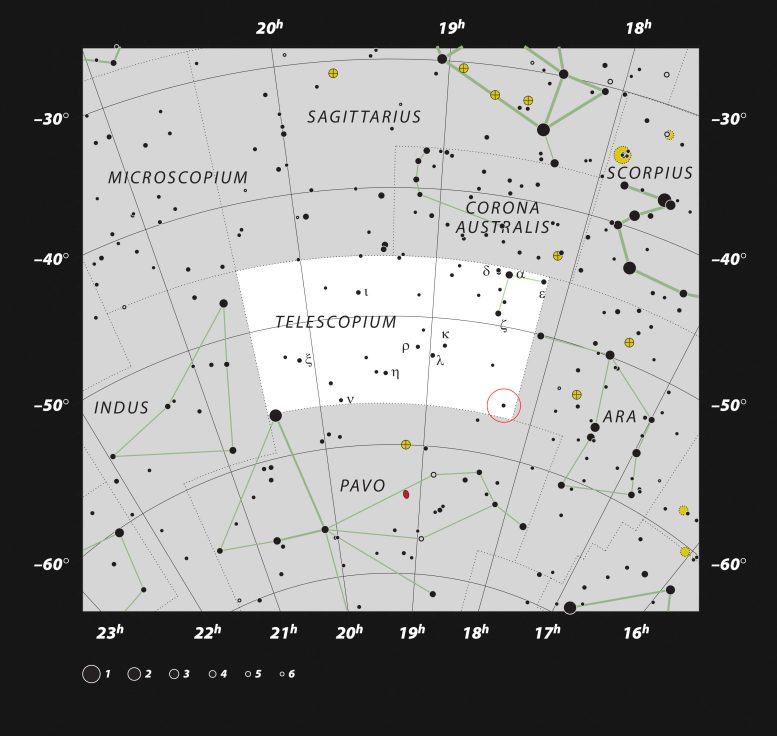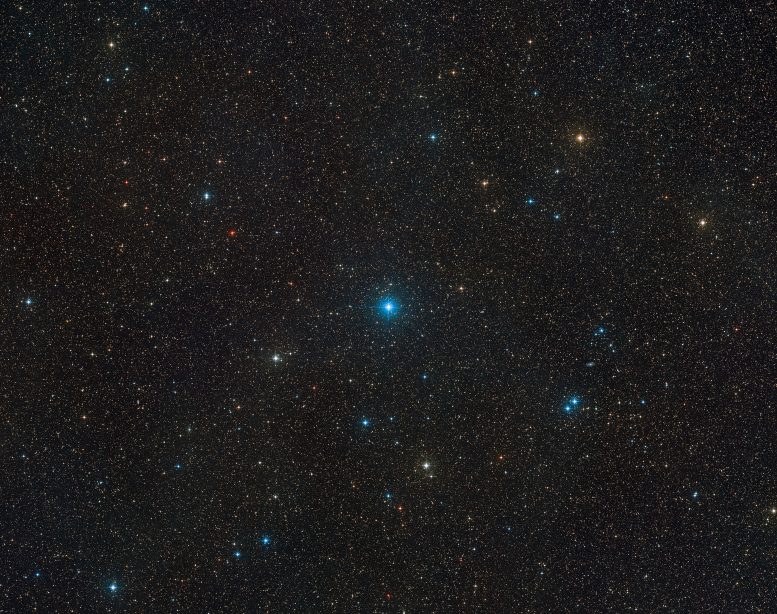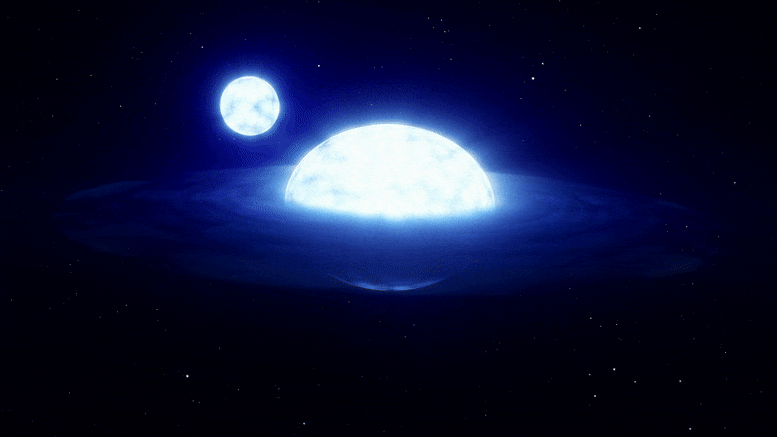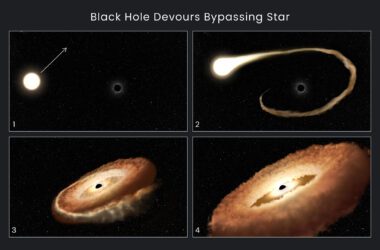En 2020, une équipe dirigée par l’Observatoire européen austral (ESO) astronomers reported the closest black hole to Earth, located just 1000 light-years away in the HR 6819 system. But the results of their study were contested by other researchers, including by an international team based at KU Leuven, Belgium. In a paper published today, these two teams have united to report that there is in fact no black hole in HR 6819, which is instead a “vampire” two-star system in a rare and short-lived stage of its evolution.
The original study on HR 6819 received significant attention from both the press and scientists. Thomas Rivinius, a Chile-based ESO astronomer and lead author on that paper, was not surprised by the astronomy community’s reception to their discovery of the black hole. “Not only is it normal, but it should be that results are scrutinized,” he says, “and a result that makes the headlines even more so.”
Une équipe a trouvé un trou noir, l’autre a contesté ses résultats. Voici l’histoire de comment ils se sont réunis pour savoir qui avait raison. Crédit : ESO
Rivinius et ses collègues étaient convaincus que la meilleure explication pour les données dont ils disposaient, obtenues avec le télescope de 2,2 mètres MPG/ESO, était que HR 6819 était un système triple, avec une étoile en orbite autour d’un trou noir tous les 40 jours et une seconde étoile sur une orbite beaucoup plus large. Mais une étude menée par Julia Bodensteiner, alors doctorante à la KU Leuven, en Belgique, a proposé une explication différente pour les mêmes données : HR 6819 pourrait aussi être un système avec seulement deux étoiles sur une orbite de 40 jours et sans trou noir du tout. Ce scénario alternatif nécessiterait que l’une des étoiles soit “dépouillée”, ce qui signifie qu’à un moment donné, elle a perdu une grande partie de sa masse au profit de l’autre étoile.
“Nous avions atteint la limite des données existantes, nous avons donc dû nous tourner vers une stratégie d’observation différente pour trancher entre les deux scénarios proposés par les deux équipes”, explique Abigail Frost, chercheuse à la KU Leuven, qui a dirigé la nouvelle étude publiée aujourd’hui (2 mars 2022) dans Astronomie & ; Astrophysique.

Une nouvelle recherche utilisant les données du Very Large Telescope et du Very Large Telescope Interferometer de l’ESO a révélé que HR 6819, que l’on croyait être un système triple avec un trou noir, est en fait un système de deux étoiles sans trou noir. Les scientifiques, une équipe KU Leuven-ESO, pensent avoir observé ce système binaire pendant un bref instant après que l’une des étoiles ait aspiré l’atmosphère de sa compagne, un phénomène souvent appelé “vampirisme stellaire”. Cette impression d’artiste montre ce à quoi le système pourrait ressembler ; il est composé d’une étoile oblate avec un disque autour d’elle (une étoile “vampire” Be ; au premier plan) et d’une étoile de type B qui a été dépouillée de son atmosphère (à l’arrière-plan). Crédit : ESO/L. Calçada
Pour résoudre le mystère, les deux équipes ont travaillé ensemble pour obtenir de nouvelles données plus nettes de HR 6819 en utilisant le Very Large Telescope (VLT) and Very Large Telescope Interferometer (VLTI). “The VLTI was the only facility that would give us the decisive data we needed to distinguish between the two explanations,” says Dietrich Baade, author on both the original HR 6819 study and the new Astronomy & Astrophysics paper. Since it made no sense to ask for the same observation twice, the two teams joined forces, which allowed them to pool their resources and knowledge to find the true nature of this system.
“The scenarios we were looking for were rather clear, very different, and easily distinguishable with the right instrument,” says Rivinius. “We agreed that there were two sources of light in the system, so the question was whether they orbit each other closely, as in the stripped-star scenario, or are far apart from each other, as in the black hole scenario.”

This chart shows the location of HR 6819 in the constellation of Telescopium. This map shows most of the stars visible to the unaided eye under good conditions and the system itself is marked with a red circle. The two stars in HR 6819 can be viewed from the southern hemisphere on a dark, clear night without binoculars or a telescope. Credit: ESO, IAU and Sky & Telescope
To distinguish between the two proposals, the astronomers used both the VLTI’s GRAVITY instrument and the Multi Unit Spectroscopic Explorer (MUSE) instrument on ESO’s VLT.
“MUSE confirmed that there was no bright companion in a wider orbit, while GRAVITY’s high spatial resolution was able to resolve two bright sources separated by only one-third of the distance between the Earth and the Sun,” says Frost. “These data proved to be the final piece of the puzzle, and allowed us to conclude that HR 6819 is a binary system with no black hole.”
“Our best interpretation so far is that we caught this binary system in a moment shortly after one of the stars had sucked the atmosphere off its companion star. This is a common phenomenon in close binary systems, sometimes referred to as “stellar vampirism” in the press,” explains Bodensteiner, now a fellow at ESO in Germany and an author on the new study. “While the donor star was stripped of some of its material, the recipient star began to spin more rapidly.”

This wide-field view shows the region of the sky, in the constellation of Telescopium, where HR 6819 can be found. This view was created from images forming part of the Digitized Sky Survey 2. The two stars in HR 6819 can be viewed from the southern hemisphere on a dark, clear night without binoculars or a telescope. Credit: ESO/Digitized Sky Survey 2, Acknowledgement: Davide De Martin
“Catching such a post-interaction phase is extremely difficult as it is so short,” adds Frost. “This makes our findings for HR 6819 very exciting, as it presents a perfect candidate to study how this vampirism affects the evolution of massive stars, and in turn the formation of their associated phenomena including gravitational waves and violent supernova explosions.”
The newly formed Leuven-ESO joint team now plans to monitor HR 6819 more closely using the VLTI’s GRAVITY instrument. The researchers will conduct a joint study of the system over time, to better understand its evolution, constrain its properties, and use that knowledge to learn more about other binary systems.
De nouvelles recherches utilisant les données du Very Large Telescope et du Very Large Telescope Interferometer de l’ESO ont révélé que HR 6819, que l’on croyait être un système triple avec un trou noir, est en fait un système de deux étoiles sans trou noir. Les scientifiques, une équipe KU Leuven-ESO, pensent avoir observé ce système binaire pendant un bref instant après que l’une des étoiles ait aspiré l’atmosphère de sa compagne, un phénomène souvent appelé “vampirisme stellaire”. Cette animation montre à quoi pourrait ressembler le système ; il est composé d’une étoile oblate entourée d’un disque (une étoile “vampire” Be ; au premier plan) et d’une étoile de type B qui a été dépouillée de son atmosphère (à l’arrière-plan). Crédit : ESO/L. Calçada
Quant à la recherche de trous noirs, l’équipe reste optimiste. “Les trous noirs de masse stellaire restent très insaisissables en raison de leur nature”, déclare Rivinius. “Mais les estimations en ordre de magnitude suggèrent qu’il y a des dizaines à des centaines de millions de trous noirs dans la Milky Way alone,” Baade adds. It is just a matter of time until astronomers discover them.
Reference: “HR 6819 is a binary system with no black hole: Revisiting the source with infrared interferometry and optical integral field spectroscopy” 2 March 2022, Astronomy & Astrophysics.
DOI: 10.1051/0004-6361/202143004
It has received funding from the European Research Council (ERC) under the European Union’s Horizon 2020 research and innovation program (grant agreement number 772225: MULTIPLES; PI: Hugues Sana).
The team is composed of A. J. Frost (Institute of Astronomy, KU Leuven, Belgium [KU Leuven]), J. Bodensteiner (European SouthernObservatoire, Garching, Allemagne [ESO]), Th. Rivinius (Observatoire européen austral, Santiago, Chili [ESO Chile]), D. Baade (ESO), A. Mérand (ESO), F. Selman (ESO Chili), M. Abdul-Masih (ESO Chili), G. Banyard (KU Leuven), E. Bordier (KU Leuven, ESO Chili), K. Dsilva (KU Leuven), C. Hawcroft (KU Leuven), L. Mahy (Observatoire royal de Belgique, Bruxelles, Belgique), M. Reggiani (KU Leuven), T. Shenar (Institut d’astronomie Anton Pannekoek, Université d’Amsterdam, Pays-Bas), M. Cabezas (Institut d’astronomie, Académie des sciences de la République tchèque, Prague, République tchèque). [ASCR]), P. Hadrava (ASCR), M. Heida (ESO), R. Klement (The CHARA Array of Georgia State University, Mount Wilson Observatory, Mount Wilson, USA) et H. Sana (KU Leuven).



